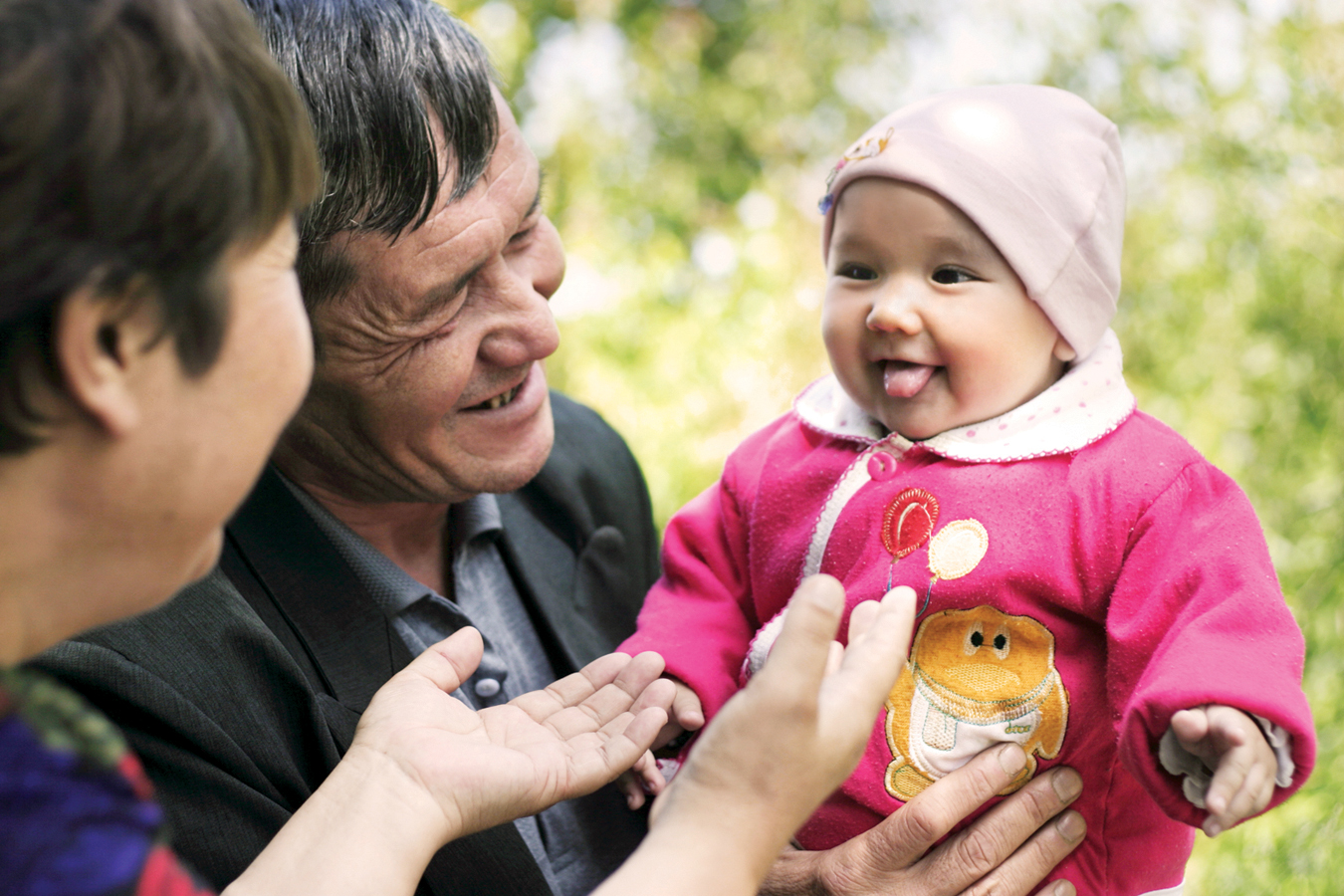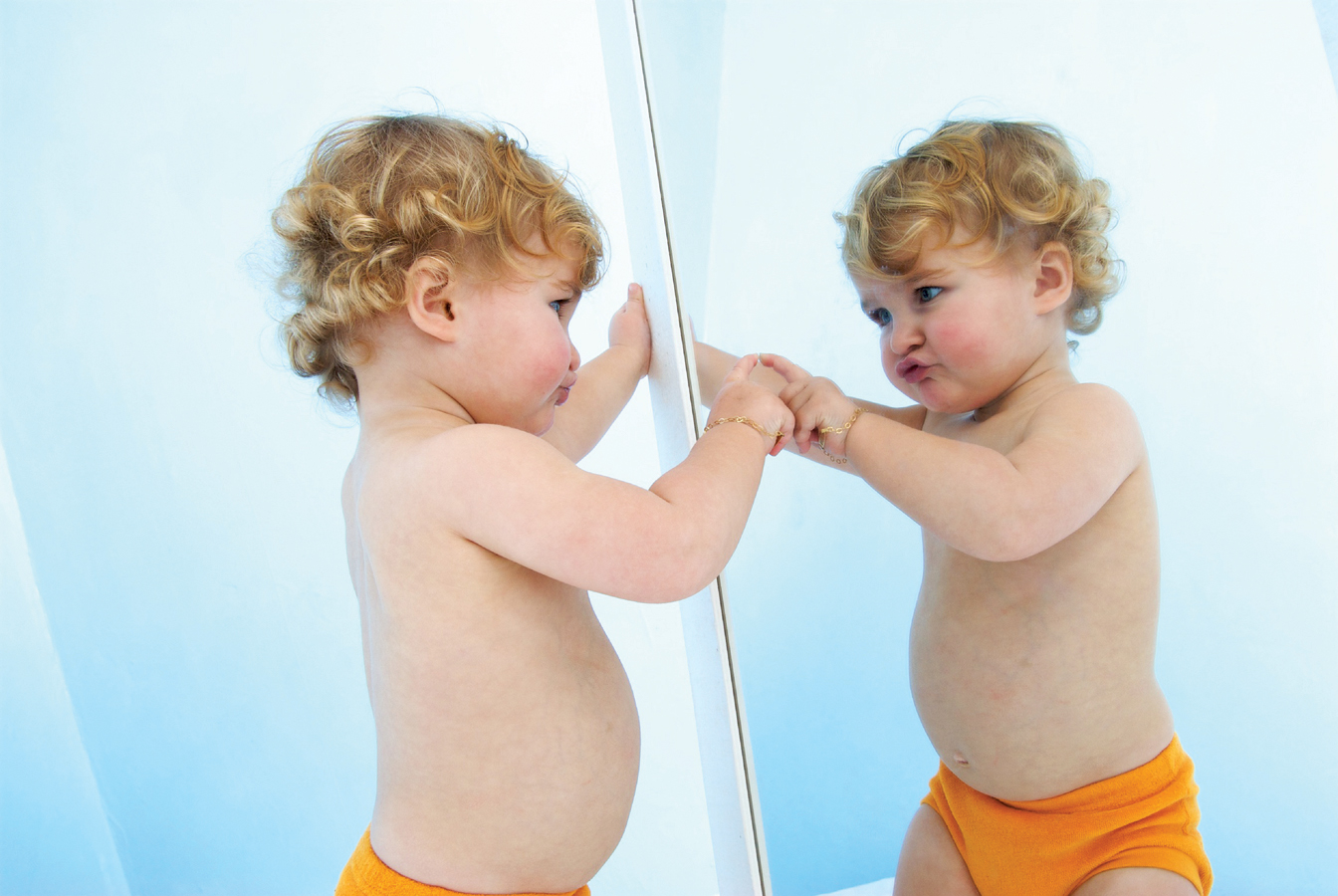4.1 Emotional Development
In the first two years, infants progress from reactive pain and pleasure to complex patterns of social awareness (see At About This Time) (Lewis, 2010). This is a period of high emotional responsiveness (Izard et al., 2002), expressed in speedy, uncensored reactions—
Ages When Emotions Emerge
| Birth | Crying; contentment |
| 6 weeks | Social smile |
| 3 months | Laughter; curiosity |
| 4 months | Full, responsive smiles |
|
4– |
Anger |
|
6– |
Fear of social events (strangers, separation from caregiver) |
| 12 months | Fear of unexpected sights and sounds |
| 18 months | Self- |
Early Emotions
The earliest emotions, also called primary emotions, emerge within the first 6 months (Izard, 1978). At first, there is pleasure and pain. Newborns are happy and relaxed when fed and drifting off to sleep. They cry when they are hurt or hungry, tired or frightened (as by a loud noise or a sudden loss of support). Some infants have bouts of uncontrollable crying, called colic—

Smiling and LaughingSoon, additional emotions become recognizable (Lavelli & Fogel, 2005). Curiosity is evident as infants (and people of all ages) respond to objects and experiences that are new but not too novel. Happiness is expressed by the social smile, evoked by a human face at about 6 weeks. A social smile is a developmental milestone as it indicates that the infant is intentionally communicating with others (e.g., inviting adults to interact with her, or responding to somebody else’s smile). Preterm babies smile a few weeks later because the social smile is determined by cognition (development of the brain), which is less developed for preterm babies.
139
Infants worldwide express social joy, even laughter, between 2 and 4 months (Konner, 2007; Lewis, 2010). Among the Navajo, whoever brings forth that first laugh gives a feast to celebrate the baby’s becoming a person (Rogoff, 2003). Laughter builds as curiosity does; a typical 6-
Anger and SadnessThe positive emotions of joy and contentment are soon joined by negative emotions, more frequent in infancy than later on (Izard, 2009). Anger is evident at 6 months, usually triggered by frustration, such as when infants are prevented from moving or grabbing.
To see how infants responded to frustration, researchers gently restrained children’s arms from behind for 2 minutes or until 20 seconds of hard crying ensued (Mills-
In infancy, anger is a healthy response to frustration, unlike sadness, which also appears in the first months. Sadness indicates withdrawal and is accompanied by an increase in the body’s production of cortisol, the primary stress hormone.
In a series of experiments, 4-
Since sadness produces physiological stress (e.g., cortisol), sorrow negatively impacts the infant. All social emotions, particularly sadness and fear, probably shape the brain (Fries & Pollak, 2007; Johnson, 2010). As you learned in Chapter 3, experience matters.
FearFear in response to some person, thing, or situation (not just starting in surprise) is evident at about 6 to 9 months and soon becomes more frequent and obvious (Witherington et al., 2004). Two kinds of social fear are typical:
- Separation anxiety—clinging and crying when a familiar caregiver is about to leave
- Stranger wariness—especially when an unfamiliar person moves too close, too quickly.
Separation anxiety is normal at age 1 year, intensifies by age 2, and usually subsides after that. Fear of separation interferes with infant sleep. For example, if infants fall asleep next to familiar people, they may wake up terrified if they are alone (Sadeh et al., 2010). Some babies become accustomed to a transitional object, such as a teddy bear or blanket, that comforts them as they transition from sleeping in their parents’ arms to sleeping alone.
Transitional objects are not pathological; they are the infant’s way to cope with anxiety. However, if separation anxiety remains strong after age 3, it is considered an emotional disorder and is accompanied by physiological signs of distress (Kossowsky et al., 2012).

140
Strangers—
Every aspect of early emotional development interacts with cultural beliefs, expressed in parental actions. There seems to be more separation anxiety and stranger wariness in Japan than in Germany because Japanese infants have very few experiences with separation from the mother, whereas in Germany, infants are more likely to experience time apart from their mothers (Saarni et al., 2006).
Toddlers’ Emotions
Emotions take on new strength during toddlerhood. This is evident in temper tantrums. Toddlers are famous for fury, when something angers them so much that they yell, scream, cry, and do something physical—
Gradually, more complex emotions emerge as toddlers develop a sense of themselves in relation to others (social awareness) and of their own uniqueness as a person (self-
Social AwarenessTemper can be seen as an expression of selfhood. So can these new and more complex emotions: pride, shame, empathy, jealousy, embarrassment, and disgust. These emotions require social awareness, which emerges from family interactions and is shaped by culture (Mesquita & Leu, 2007).
Pride is experienced when the toddler feels joy at doing something successfully (Stipek et al., 1992). For example, many North American parents encourage toddler pride (saying, “You did it yourself!”), but Asian families typically discourage pride. Instead, they cultivate modesty and shame. Shame happens when a child thinks he or she has failed to meet the standards and expectations set by family or culture. This emotion then makes the child want to hide or disappear (Lewis, 1992).
Embarrassment occurs when a toddler feels confused and awkward as the result of unwanted attention. For example, a little boy can feel embarrassed simply from being stared at or pointed at by strangers. The difference between embarrassment and shame that shame stems from a sense of failure, but embarrassment is a result of unwanted attention from others, such as when an older person points at a child and exclaims, “Isn’t she adorable!”
ESPECIALLY FOR Nurses and Pediatricians Parents come to you concerned that their 1-
The emotion of empathy allows a young child to actually share another person’s feelings. It is not uncommon for a toddler to look sad in the presence of a playmate who is crying and to pat that other child on the back (Lewis, 2007). Jealousy, on the other hand, makes a child want what someone else has, whether that something is a toy or food or attention.
Disgust as a physical reaction to an unpleasant taste or smell is evident very early. Even infants younger than 6 months will immediately spit out food that tastes bad or smells unpleasant. Disgust at a more complex level is strongly influenced by other people and age. For example, 18-
By age 2, most children display the entire spectrum of emotions, and they begin to regulate their reactions, with more fear or boldness depending on experience (Saarni et al., 2006). For example, many toddlers hide behind their parents when a dog approaches. Depending on how their mother or father reacts to the dog, and their prior experience with pets, the toddler may peek out and perhaps pet the dog himself or herself.
141
Self-
Very young infants have no sense of self—
Some aspects of selfhood emerge before age 1, but
more complex self-
[Thompson, 2006]
In a classic experiment known as the mirror/rouge test (Lewis & Brooks, 1978), 9-

KEY points
- Newborns experience such basic emotions as distress and contentment, expressed by crying or looking relaxed.
- Older babies feel curiosity, joy, anger (when they are kept from something they want), and fear (when something unexpected occurs).
- Toddlers express many emotions that indicate awareness of themselves and others, such as empathy, jealousy, and embarrassment.
- Cultural expectations and parental actions influence emotions.